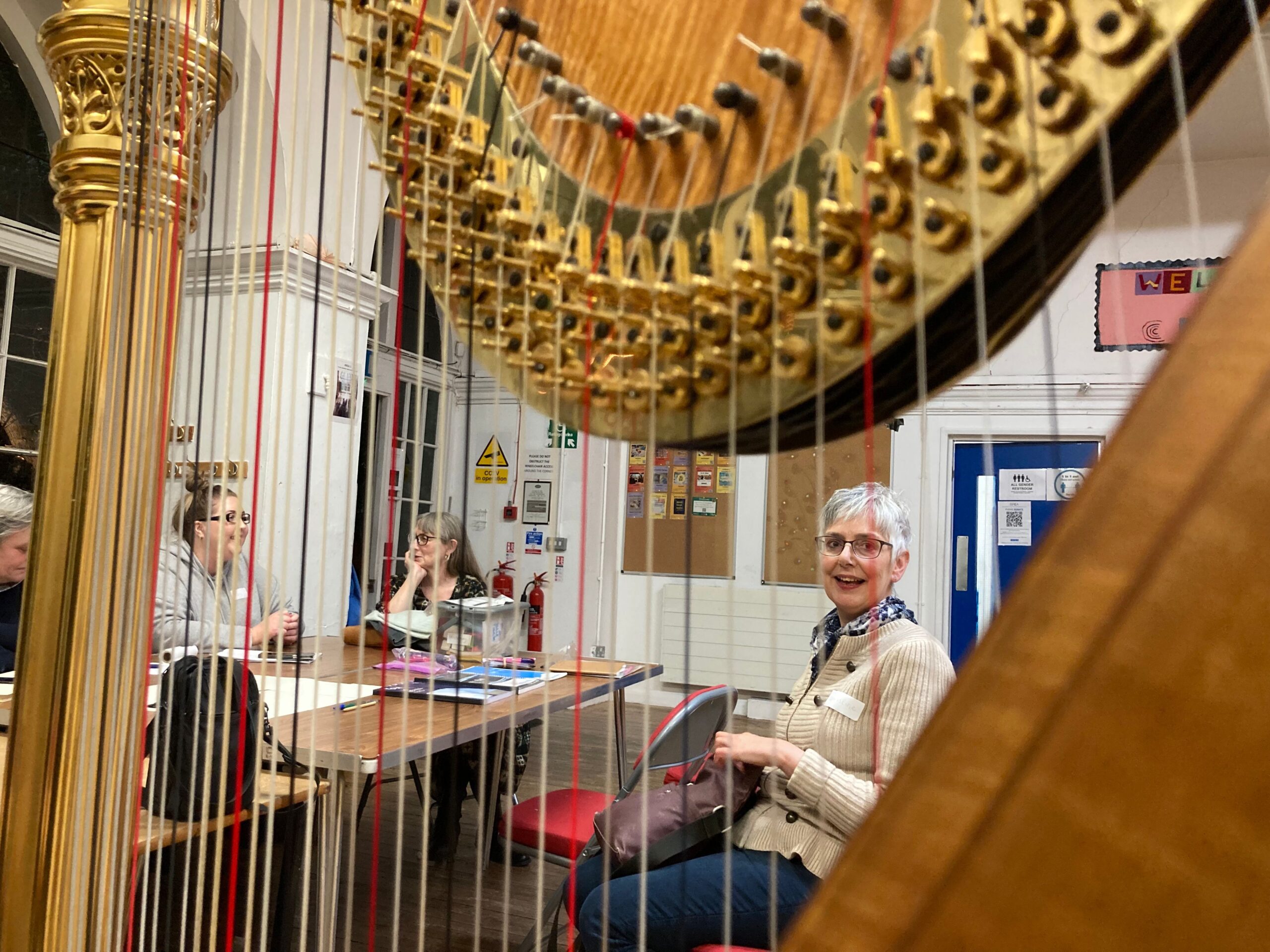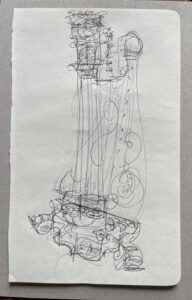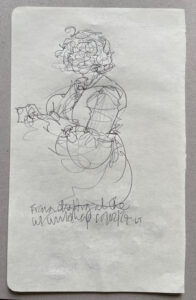Writing to the harp in the East End

“What a treat to write to music and to look up close at the beautiful beast that is a harp. Thank you for your wonderful workshop.”
Lydia Thornley sent this lovely message following my harp and writing workshop for the fabulous women of the East End Women’s Institute last week.
The beautiful beast that is a harp
“Beautiful beast” sums up the contradictions of the harp for me. The harp’s gilded exterior and ethereal sound are beguiling, but the instrument is also heavy (around 60kg) and full of complex machinery and moving parts.
People at the workshop were surprised to discover, for example, that the harp has seven pedals – one for each note of the scale from A to G. They’re linked to levers that are hidden inside the pillar and tighten the strings a semi-tone at a time to accommodate key changes and accidentals.
Capturing the essence of the harp

As I was setting up, in just a few seconds, Lydia produced this wonderful illustration of the harp, generated with a few deft strokes of a biro. I’m amazed at how accurately she captured the essence of the harp: the strings, the curlicues of the pattern on the soundboard, the intricate engravings on the pillar, the elaborate decorations around the base. Somehow, the gilding comes through, even though the drawing is simple black ink on cream paper.
Lydia works as a graphic designer, creative director and sketcher. Follow her on Instagram @lydiathornley and see more of her beautiful watercolours of flowers and wildlife, alongside quick-fire sketches of London commuters and their four-legged companions.
Squiggly me

Lydia also dashed off this impression of me as I chatted to people in the workshop. I am all curly hair and puffed sleeves.
Automatic writing
In the workshop, I played a series of short pieces, each with a specific writing prompt, and encouraged people to create ‘automatic writing’ in response. I’ve run this workshop before, but this was the first time I’d held a live workshop since lockdown, so it was a treat to be in the room with people.
For many of the group, it was the first time they’d seen a harp up close, and certainly the first time they’d been asked to write along to music. There were some initial reservations.
“I think beforehand many of us were curious, and perhaps apprehensive, about what a music and creative writing session might demand of us,” said Heather Qualtrough, President of East End WI. “But you will know how much it was appreciated by the responses from all those lucky enough to attend.”
Surprising and touching responses
For each piece, I would give people two or three words to use as writing inspiration. I asked them to follow the rules outlined by Natalie Goldberg in her book, ‘Writing down the Bones’. Keep your hand moving, don’t censor yourself and don’t edit as you go. Everyone responded differently to the various writing prompts. I was particularly struck by one person’s response to the prompt ‘I don’t remember’. The writer dived off from this point into a story about dementia, which was both unexpected and poignant.
Heather commented: “I think we were all moved by the stories that emerged from the harp inspiration. Perhaps for me the description of forgetting, experienced by a friend with early Dementia was the most touching, but with the range of prompts there was room for many different emotions.”
Have a go at a glissando
I also gave people the opportunity to have a go on the harp, playing a glissando. The term comes from the Italian meaning ‘to slide’, and it involves running your thumb down from the top of the harp and coming back up again using your index finger. I explained that you have to play in the middle of the strings to get the maximum resonance and to give it some welly, rather than just tickling the strings, to generate some volume.
Heather said: “I know we all impressed ourselves with being able to play a glissando on your lovely harp, but we are realistic enough to realise that that is not an indication of our own hidden musical genius, but your careful instruction and the obliging, magnificent and beautiful instrument!”
Discover more
- Read Lydia’s account of the evening on the East End WI blog.
- Read about my work with music clients.
- Find out about my writing training courses and workshops.